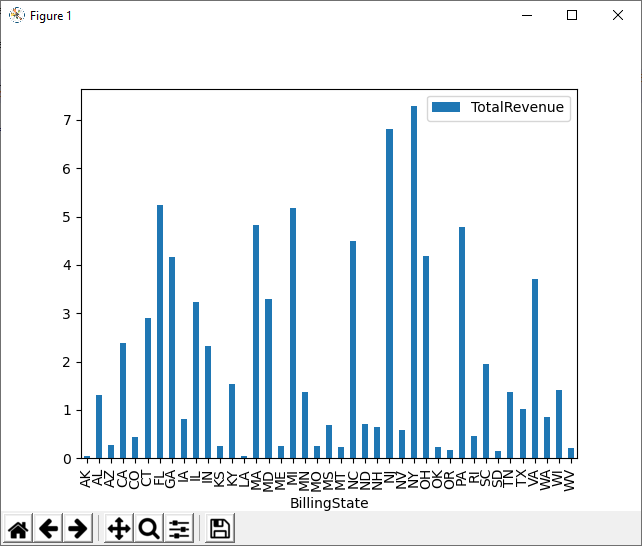Model Context Protocol (MCP) finally gives AI models a way to access the business data needed to make them really useful at work. CData MCP Servers have the depth and performance to make sure AI has access to all of the answers.
Try them now for free →How to Visualize QuickBooks Online Data in Python with pandas
Use pandas and other modules to analyze and visualize live QuickBooks Online data in Python.
The rich ecosystem of Python modules lets you get to work quickly and integrate your systems more effectively. With the CData Python Connector for QuickBooks Online, the pandas & Matplotlib modules, and the SQLAlchemy toolkit, you can build QuickBooks Online-connected Python applications and scripts for visualizing QuickBooks Online data. This article shows how to use the pandas, SQLAlchemy, and Matplotlib built-in functions to connect to QuickBooks Online data, execute queries, and visualize the results.
With built-in optimized data processing, the CData Python Connector offers unmatched performance for interacting with live QuickBooks Online data in Python. When you issue complex SQL queries from QuickBooks Online, the driver pushes supported SQL operations, like filters and aggregations, directly to QuickBooks Online and utilizes the embedded SQL engine to process unsupported operations client-side (often SQL functions and JOIN operations).
About QuickBooks Online Data Integration
CData provides the easiest way to access and integrate live data from QuickBooks Online. Customers use CData connectivity to:
- Realize high-performance data reads thanks to push-down query optimization for complex operations like filters and aggregations.
- Read, write, update, and delete QuickBooks Online data.
- Run reports, download attachments, and send or void invoices directly from code using SQL stored procedures.
- Connect securely using OAuth and modern cryptography, including TLS 1.2, SHA-256, and ECC.
Many users access live QuickBooks Online data from preferred analytics tools like Power BI and Excel, directly from databases with federated access, and use CData solutions to easily integrate QuickBooks Online data with automated workflows for business-to-business communications.
For more information on how customers are solving problems with CData's QuickBooks Online solutions, refer to our blog: https://www.cdata.com/blog/360-view-of-your-customers.
Getting Started
Connecting to QuickBooks Online Data
Connecting to QuickBooks Online data looks just like connecting to any relational data source. Create a connection string using the required connection properties. For this article, you will pass the connection string as a parameter to the create_engine function.
QuickBooks Online uses the OAuth authentication standard. OAuth requires the authenticating user to log in through the browser. To authenticate using OAuth, you can use the embedded OAuthClientId, OAuthClientSecret, and CallbackURL or you can obtain your own by registering an app with Intuit. Additionally, if you want to connect to sandbox data, set UseSandbox to true.
See the Getting Started chapter of the help documentation for a guide to using OAuth.
Follow the procedure below to install the required modules and start accessing QuickBooks Online through Python objects.
Install Required Modules
Use the pip utility to install the pandas & Matplotlib modules and the SQLAlchemy toolkit:
pip install pandas pip install matplotlib pip install sqlalchemy
Be sure to import the module with the following:
import pandas import matplotlib.pyplot as plt from sqlalchemy import create_engine
Visualize QuickBooks Online Data in Python
You can now connect with a connection string. Use the create_engine function to create an Engine for working with QuickBooks Online data.
engine = create_engine("quickbooksonline:///?InitiateOAuth=GETANDREFRESH&OAuthSettingsLocation=/PATH/TO/OAuthSettings.txt")
Execute SQL to QuickBooks Online
Use the read_sql function from pandas to execute any SQL statement and store the resultset in a DataFrame.
df = pandas.read_sql("SELECT DisplayName, Balance FROM Customers WHERE FullyQualifiedName = 'Cook, Brian'", engine)
Visualize QuickBooks Online Data
With the query results stored in a DataFrame, use the plot function to build a chart to display the QuickBooks Online data. The show method displays the chart in a new window.
df.plot(kind="bar", x="DisplayName", y="Balance") plt.show()

Free Trial & More Information
Download a free, 30-day trial of the CData Python Connector for QuickBooks Online to start building Python apps and scripts with connectivity to QuickBooks Online data. Reach out to our Support Team if you have any questions.
Full Source Code
import pandas
import matplotlib.pyplot as plt
from sqlalchemy import create_engin
engine = create_engine("quickbooksonline:///?InitiateOAuth=GETANDREFRESH&OAuthSettingsLocation=/PATH/TO/OAuthSettings.txt")
df = pandas.read_sql("SELECT DisplayName, Balance FROM Customers WHERE FullyQualifiedName = 'Cook, Brian'", engine)
df.plot(kind="bar", x="DisplayName", y="Balance")
plt.show()

